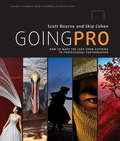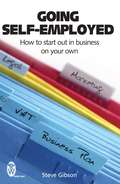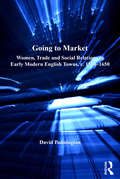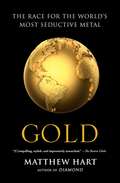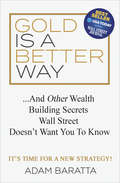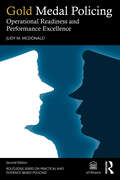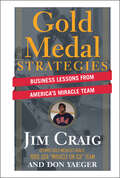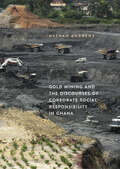- Table View
- List View
Going Pro: How to Make the Leap from Aspiring to Professional Photographer
by Skip Cohen Scott BourneYou've got the gear, the training, and the technology. You're ready to make the leap from aspiring to professional photographer. Now what? With today's affordable, high-quality cameras, Internet technology, and training, any weekend warrior can hang a shingle and open a photography business. But what then? While anyone can buy a professional quality camera, few have the skills to turn their dreams into a profitable business.Going Pro is the essential guide to leaping successfully into any genre of professional photography. Industry powerhouses Scott Bourne and Skip Cohen share invaluable advice on defining your niche, putting together a portfolio, pricing and showing your work, marketing, positioning your brand, and, most important, building an online social media platform from the ground up. Throughout, advice and tips are offered from 25 of the biggest names in the industry, including Chase Jarvis, Vincent Laforet, Matthew Jordan Smith, Jeremy Cowart, Jules Bianchi, Bambi Cantrell, Tony Corbell, Kevin Kubota, Jerry Ghionis, and more.Hundreds of thousands of photographers are already tuning in to the Going Pro podcast and blog (goingpro2011.com). Going Pro, the book, now joins the movement, giving amateurs everywhere the confidence and tools they need to make the leap into professional photography.
Going Public im Deutschen Reich: Die Börseneinführungstätigkeit von Aktien im Zeitraum 1917 bis 1945
by Patrick KozikDie seit Anfang der 1980er Jahre bestehende intensive Forschung zu Börseneinführungen am deutschen Kapitalmarkt ermöglicht zuverlässige Forschungsresultate für die Zeiträume 1870 bis 1914 sowie ab dem Jahr 1948. Eine vollständige IPO-Zeitreihe für die dazwischenliegenden Jahre konnte bisher nicht präsentiert werden. Diese bestehende Forschungslücke wird nunmehr geschlossen, indem mit dem vorliegenden Buch erstmals eine vollständige Zeitreihe von Börseneinführungen für den Zeitraum 1917 bis 1945 vorgelegt wird. Zusätzlich ist es in Zusammenstellung mit bisherigen Forschungsreihen erstmalig möglich, eine lückenlose Zeitreihe von Börseneinführungen seit der Reichsgründung 1871 bis zur heutigen Börsenentwicklung zu erhalten. Darüber hinaus leistet dieser Band einen Beitrag zur Beschreibung der historischen Börsenorganisation, zur Validierung bestehender Modellansätze unter Berücksichtigung ökonomischer und politischer Schocks sowie den Nachweis positiver Emissionsrenditen für die Zwischenkriegsjahre.
Going Public: Adventures in Capital Markets
by Richard LueckeGrowing firms with exceptional revenue potential may seek financing through an initial public offering (IPO) of their ownership shares to the world of individual and institutional investors, resulting in the exchange of paper ownership shares for the hard cash the firm needs for stability and expansion. This chapter outlines the pros and cons of going public and details the process and its alternatives for those who are ready for that option.
Going Public: How Silicon Valley Rebels Loosened Wall Street's Grip on the IPO and Sparked a Revolution
by Dakin CampbellA behind-the-scenes tour of the high-stakes world of IPOs and how a visionary band of startup executives, venture capitalists, and maverick bankers has launched a crusade to upend the traditional IPO as we know it.GOING PUBLIC is a character-driven narrative centered on the last five years of unparalleled change in how technology startups sell shares to the public. Initial public offerings, or IPOs, are typically the first time retail investors can own a piece of the New Economy companies promising to rewire economic rules. Selling IPOs is also one of the most profitable businesses for Wall Street investment banks, who have spent the last 40 years protecting their profits. In an era when algorithms and software have made the financial markets more efficient, the pricing of IPOs still relies on human judgment. In 2018, executives at music-streaming service Spotify sought to upend the status quo. Led by a trim and understated CFO, Barry McCarthy, and a shy but brilliant founder, Daniel Ek, they took a wild idea and forged something new. GOING PUBLIC explores how they got comfortable with the risk, and how they lobbied securities watchdogs and exchange staff to rewrite the regulations. Readers will meet executives at disruptive companies like Airbnb, DoorDash, venture capitalists, and even some bankers who seized on Spotify&’s labor and used it to knock Wall Street bankers off the piles of fees they&’d been stacking for so long. GOING PUBLIC weaves in earlier attempts to rethink the IPO process, introducing readers to one of Silicon Valley&’s earliest bankers, Bill Hambrecht, whose invention for selling shares online was embraced by Google founders Larry Page and Sergey Brin when they auctioned their shares in 2004. And it examines the recent boom in blank-check companies, those Wall Street insider deals that have suddenly become the hottest way to enter the public markets. GOING PUBLIC tells stories from inside the room, and more.
Going Remote: How the Flexible Work Economy Can Improve Our Lives and Our Cities
by Matthew E. KahnA leading urban economist's hopeful study of how shifts to remote work can change all of our lives for the better. As COVID-19 descended upon the country in 2020, millions of American office workers transitioned to working from home to reduce risk of infection and prevent spread of the virus. In the aftermath of this shift, a significant number of workers remain at least partially remote. It is clear that this massive experiment we were forced to run will have long-term consequences, changing the shape of our personal and work lives, as well as the urban landscape around us. How will the rise of telecommuting affect workers' quality of life, the profitability of firms, and the economic geography of our cities and suburbs? Going Remote addresses the uncertainties and possibilities of this moment. In Going Remote, urban economist Matthew E. Kahn takes readers on a journey through the new remote-work economy, revealing how people will configure their lives when they have more freedom to choose where they work and how they live. Melding ideas from labor economics, family economics, the theory of the firm, and urban economics, Kahn paints a realistic picture of the future for workers, firms, and urban areas, big and small. As Kahn shows, the rise of remote work presents especially valuable opportunities for flexibility and equity in the lives of women, minorities, and young people, and even for those whose jobs do not allow them to work from home. Uncovering key implications for our quality of life, Going Remote demonstrates how the rise of remote work can significantly improve the standard of living for millions of people by expanding personal freedom, changing the arc of how we live, work, and play.
Going Self-Employed: How to Start Out in Business on Your Own
by Steve GibsonAssess whether you've got the right characteristics to make a success of self-employment.Learn about business plans; survival income; discounting; researching your market; targeting your customers; listening to your customers and keeping them happy; marketing and selling; promoting your business; tax, national insurance and VAT.Further help is provided by the author's own website www.startbusiness.co.uk from where readers can download software to help calculate their survival income, cashflow, and profit and loss, as well as access information about start-up ideas.In addition, there's an "Online Directory" section with useful links to other websites.
Going Self-Employed: How to Start Out in Business on Your Own
by Steve GibsonAssess whether you've got the right characteristics to make a success of self-employment.Learn about business plans; survival income; discounting; researching your market; targeting your customers; listening to your customers and keeping them happy; marketing and selling; promoting your business; tax, national insurance and VAT.Further help is provided by the author's own website www.startbusiness.co.uk from where readers can download software to help calculate their survival income, cashflow, and profit and loss, as well as access information about start-up ideas.In addition, there's an "Online Directory" section with useful links to other websites.
Going Social: Durex in China
by Aaron Smith Mikolaj Jan PiskorskiWhen Reckitt Benckiser (RB), a leading consumer goods company, first entered China, it encountered significant challenges. RB's strategy relied on selling high margin products supported by cost-effective advertising and distribution, but the highly competitive Chinese market made it hard to sustain high margins, inflated television advertising rates made marketing expensive, and an inefficient distribution system increased costs further. In 2010, RB managed to overcome these constraints for one of its brands, Durex, the best-selling condom brand in the world, by leveraging Chinese social media platforms and investing in offline and online distribution. The new strategy paid off - Durex condom sales increased threefold in China and market share increased by over 10%. RB now wanted to generate the same results for its other brands in the country, and needed to decide how to balance investments in offline distribution, social media campaigns, and e-commerce in order to keep growing not just in China, but in other emerging markets as well.
Going Social: Excite Customers, Generate Buzz, and Energize Your Brand with the Power of Social Media
by Jeremy GoldmanIf you're not social, it's like you're not even there. That's how critical social media marketing has become. Businesses everywhere are struggling to adapt, but transitioning from traditional marketing to online engagement is fraught with questions, such as: How much is a Facebook "like" worth? How can you effectively engage online influencers? What are the best dashboards for monitoring multiple social channels simutaneously? How do you keep it all going around the clock? For more than a decade, author Jeremy Goldman has helped companies inject "social" into their processes. In Going Social, he explains the ins-and-outs of platforms such as Facebook,Twitter, LinkedIn, Google+, Foursquare, Instagram, Pinterest, and others - and shows readers how to: - Formulate a social strategy - Pinpoint their audience and where they "live" online - Give their brand a unique voice and personality - Get good at listening - Create relevant, engaging content - Identify and reward influencers - Build strong bonds with bloggers - Become truly customer-centric - Avoid pitfalls when possible - and respond to negative feedback when a misstep is made - Cultivate brand spokespeople - Use targeting to engage more effectively - Turn employees into social marketers - Engage with ROI in mind The digital landscape offers unprecedented opportunities to breathe new life into brands, spread the word about products, and magnify loyalty. Featuring insights from entrepreneurs, social media directors, community managers, bloggers, and other experts, Going Social is an indispensable guide to connecting with customers in the brave new social frontier.
Going Viral: COVID-19 and the Accelerated Transformation of Jobs in Latin America and the Caribbean (World Bank Latin American and Caribbean Studies)
by Morris Guillermo Beylis Roberto Fattal Jaef Rishabh SinhaCOVID-19 started as a health emergency, but it is rapidly evolving into an employment crisis. There is still uncertainty on how severe the economic impact of the pandemic will be. As things go, however, the drag on the region’s employment could last longer than the epidemic itself. Beyond the immediate impacts on the level of employment, the crisis is deepening and accelerating the transformation of jobs, bringing the future closer. Going Viral: COVID-19 and the Accelerated Transformation of Jobs in Latin America and the Caribbean focuses on recent trends in the economies of the region that have been significantly changing the labor market: premature deindustrialization, the servicification of the economy, and the changing skill requirements of jobs as automation advances. The findings of this report have important implications for economic policy. Some of these implications are related to the productivity challenges that Latin America and the Caribbean was already facing after the end of the “Golden Decade†? in 2013. Other policy implications see their relevance enhanced by the COVID-19 crisis. As sectors are impacted in different ways, as new technologies are developed and adopted, and as working remotely becomes more common, governments need to respond in ways that support a smooth transformation of jobs—one that is socially acceptable and that contributes to productivity growth, including investing in the human capital of the workforce. The accelerated transformation of jobs also calls for a rethinking of labor regulations and social protection policies. The institutional architecture geared to wage earners in the formal sector is quickly becoming outdated. The report calls for the flexible regulation of the emerging forms of work, in a way that encourages employment and supports formalization, thereby expanding the coverage of social protection. to larger segments
Going Viral: The 9 Secrets Of Irresistible Marketing
by Brent CokerEveryone wants their voice to be heard above the noise of other brands. But how do you get your messages to spread far and wide? <p><p> It’s not just down to luck. If you want to make an impact, you need to make your marketing messages magnetic and, in this fascinating book, Brent Coker will show you how. Packed full of practical techniques, expert research and real-life examples, you’ll quickly uncover the nine secrets of irresistible marketing that will work whatever the size of your company. Discover the science behind the world’s most viral ideas, learn how to create messages that people can’t resist sharing and effortlessly build your brand.
Going Wireless
by Jaclyn EastonGoing Wireless delivers the unexpected by showing how wireless is transforming every type of enterprise from micro-businesses to multi-national conglomerates.Award-winning technology journalist Jaclyn Easton begins with an in-depth look at owning your customers and clients through mobile commerce-whether your company focuses on consumers or business-to-business.From there you will learn about the advantages of wirelessly fortifying your mobile workforce of itinerant executives, sales personnel, and field service technicians as well as how wireless is dramatically redefining customer service, marketing, and advertising.Going Wireless also delves deep inside the corporation. First you'll find out why most companies are "handsizing" in addition to deploying wireless technology to rejuvenate warehouses, supply chains, procurement procedures, data collection, competitive intelligence, and much more.The best part is that these scenarios are supported by over 40 brand-name success stories, including:How Sears saves millions by wirelessly enabling 100 percent of their appliance repair technicians;How the Gap proved that by sewing wireless technology in their clothing they could reduce labor distribution costs by 50 percent;How McKessanHBOC-a Fortune 40 corporation-used mobile technology to entirely eliminate all their manifest imaging costs.While most people associate wireless with cell phones and Palm handhelds, you'll also learn that wireless has been around for over 100 years and has spawned mobile options you've never heard of and is being used in ways you've never imagined.This makes Going Wireless the perfect book for executives and managers who need a comprehensive overview of the wireless options that can make their companies more competitive, more productive, and more profitable.
Going the Distance: Eurasian Trade and the Rise of the Business Corporation, 1400-1700 (The Princeton Economic History of the Western World #88)
by Ron HarrisBefore the seventeenth century, trade across Eurasia was mostly conducted in short segments along the Silk Route and Indian Ocean. Business was organized in family firms, merchant networks, and state-owned enterprises, and dominated by Chinese, Indian, and Arabic traders. However, around 1600 the first two joint-stock corporations, the English and Dutch East India Companies, were established. Going the Distance tells the story of overland and maritime trade without Europeans, of European Cape Route trade without corporations, and of how new, large-scale, and impersonal organizations arose in Europe to control long-distance trade for more than three centuries.Ron Harris shows that by 1700, the scene and methods for global trade had dramatically changed: Dutch and English merchants shepherded goods directly from China and India to northwestern Europe. To understand this transformation, Harris compares the organizational forms used in four major regions: China, India, the Middle East, and Western Europe. The English and Dutch were the last to leap into Eurasian trade, and they innovated in order to compete. They raised capital from passive investors through impersonal stock markets and their joint-stock corporations deployed more capital, ships, and agents to deliver goods from their origins to consumers.Going the Distance explores the history behind a cornerstone of the modern economy, and how this organizational revolution contributed to the formation of global trade and the creation of the business corporation as a key factor in Europe’s economic rise.
Going to Market
by Robert J. DolanDescribes the major issues in deciding how to reach the market. Covers issues of channel design and channel management.
Going to Market: Women, Trade and Social Relations in Early Modern English Towns, c. 1550-1650
by David PenningtonGoing to Market rethinks women’s contributions to the early modern commercial economy. A number of previous studies have focused on whether or not the early modern period closed occupational opportunities for women. By attending to women’s everyday business practices, and not merely to their position on the occupational ladder, this book shows that they could take advantage of new commercial opportunities and exercise a surprising degree of economic agency. This has implications for early modern gender relations and commercial culture alike. For the evidence analyzed here suggests that male householders and town authorities alike accepted the necessity of women’s participation in the commercial economy, and that women’s assertiveness in marketplace dealings suggests how little influence patriarchal prescriptions had over the way in which men and women did business. The book also illuminates England’s departure from what we often think of as a traditional economic culture. Because women were usually in charge of provisioning the household, scholars have seen them as the most ardent supporters of an early-modern ’moral economy’, which placed the interests of poor consumers over the efficiency of markets. But the hard-headed, hard-nosed tactics of market women that emerge in this book suggests that a profit-oriented commercial culture, far from being the preserve of wealthy merchants and landowners, permeated early modern communities. Through an investigation of a broad range of primary sources-including popular literature, criminal records, and civil litigation depositions-the study reconstructs how women did business and negotiated with male householders, authorities, customers, and competitors. This analysis of the records shows women able to leverage their commercial roles and social contacts to defend the economic interests of their households and their neighborhoods.
Going to the Oracle: Goldman Sachs, September 2008
by David Lane Clayton RoseOn September 23, 2008, in the midst of an historic crisis in the U.S. financial markets, Warren Buffet's Berkshire Hathaway invested $5 billion in Goldman Sachs. Goldman CEO, Lloyd Blankfein, said: "We are pleased that given our longstanding relationship, Warren Buffett, arguably the world's most admired and successful investor, has decided to make such a significant investment in Goldman Sachs." He added that the deal "will further bolster our strong capitalization and liquidity position," calling Buffett's decision "a strong validation of our client franchise and future prospects." For his part, Buffett called Goldman "an exceptional institution" with "...an unrivaled global franchise, a proven and deep management team, and the intellectual and financial capital to continue its track record of outperformance." This case provides an opportunity to evaluate Goldman's decision to raise capital, the cost of the firm of Buffett's investment, and the decision by Warren Buffett to make the investment, all in the context of a profound market crisis that may have altered the usual metrics for such decisions.
Gold
by Matthew HartFrom the lost empires of the Sahara to today's frenzied global gold rush, a blazing exploration of the human love affair with gold by Matthew Hart, the award-winning author of Diamond In the wake of the 2008 financial crisis, the price of gold skyrocketed--in three years more than doubling from $800 an ounce to $1900. This massive spike drove an unprecedented global gold-mining and exploration boom, much bigger than the Gold Rush of the 1800s. In Gold, acclaimed author Matthew Hart takes you on an unforgettable journey around the world and through history to tell the extraordinary story of how gold became the world's most precious commodity. Beginning with a page-turning dispatch from the crime-ridden inferno of the world's deepest mine, Hart pulls back to survey gold's tempestuous past. From the earliest civilizations, 6,000 years ago, when gold was an icon of sacred and kingly power, Hart tracks its evolution, through conquest, murder, and international mayhem, into the speculative casino-chip that the metal has become. Hart describes each boom and bust in gold's long story, culminating in the swift and startling emergence of China as the world's new gold titan. In writing that Publishers Weekly calls "polished and fiery," Hart weaves together history and cutthroat economics to reveal the human dramas that have driven our lust for a precious yellow metal.
Gold Bubble
by Yoni JacobsHow do TV shows, vending machines, Chinese taxi companies, and a former UK prime minister point to a gold bubble that is about to burst?Many investors consider gold a "safe haven" that will shelter them from recessions, falling markets, and the depreciating value of currency. Many fail to realize, however, that investing in gold at these levels is extremely risky. "We Buy Gold" stores line busy streets, gold miners are no longer protecting themselves from a potential drop in prices, and gold is even being sold in vending machines.All this points to one thing: a gold bubble has formed and will collapse very soon, hurting investors, funds, and banks. In Gold Bubble: Profiting From Gold's Impending Collapse, Yoni Jacobs looks at how you can protect yourself.Presenting an in-depth analysis of gold dating back over a hundred years, the book explores the structural factors that have allowed gold to form a bubble, why an investor psychology of fear and greed is leading to extremely speculative behavior, why gold will fall during an upcoming recession, what effect the dollar and the stock market will have on the future of gold prices, and how to profit from a gold collapse while the majority of investors lose out.There are plenty of warning signs that gold is about to decline and this book will help you to get readyGold Bubble is the only book to argue that a gold bust is coming, going head-to-head with the herd mentalityFilled with practical advice on how to protect yourself and even profit from gold's collapse by being prepared for what's aheadWith gold prices up over 2,500 percent since 1970, and more than 600 percent since 1999, a bubble has formed and is on the verge of bursting. But until now, no one has been willing to publicly bet against the universal currency. With Gold Bubble you are ready to meet this challenge head on, and take advantage of what other investors won't even acknowledge.
Gold Is a Better Way: . . . And Other Wealth Building Secrets Wall Street Doesn't Want You To Know
by Adam BarattaThe shocking truth about where the markets are headed and why owning physical gold—not paper assets—is a far better strategy to building real wealth. An indispensable resource for the everyday investor, Gold Is A Better Way turns the strategies recommended by Wall Street on their head and makes the case for a return to sound investing. Adam Baratta strips away all the confusion and complexities surrounding investing and breaks down investment concepts and the simple fundamentals driving markets. He provides a roadmap for how to win at the game of investing and, more importantly, explains the &“why&” so readers can continue to win. Everyday investors gain tools that allow them to know with certainty they are making sound investment decisions, as well as an understanding of where to diversify investments that have historically performed well. There is a massive environmental shift happening in financial markets. Interest rates are rising and what has been very easy for investors in the past is about to become very hard. Everything people think they know about investing is being turned on its head. It's time to change investing behavior. &“A fresh new voice in the world of gold . . . Baratta&’s book and cutting edge platform make the undeniable case why gold demands consideration in every portfolio.&” —ZeroHedge
Gold Medal Policing: Operational Readiness and Performance Excellence (Routledge Series on Practical and Evidence-Based Policing)
by Judy M. McDonaldThis straightforward, easy-to-understand textbook inspires tools for improving job performance, productivity, and morale in law enforcement. The groundbreaking first edition of Gold Medal Policing, inspired by work with Olympic athletes, confirmed the importance of mental readiness in frontline policing excellence. Partnerships with policing and related fields positioned Gold Medal Policing principles across recruitment, multilevel training, web-based learning, and field assessment.The second edition consolidates two decades of peer-reviewed research and training, reflecting new trends, lessons, contemporary issues, and proven tools. Drawing on insights from frontline officers recognized for their excellence, including coach officers, it introduces an Operational Readiness Framework rooted in scientific principles. This framework systematically assesses physical, technical, and mental readiness, creating a detailed police-specific profile. A comprehensive literature review informs current police preparedness practices. Mental readiness is upheld to strict, measurable standards, akin to traditional physical and technical readiness. Best practices from exceptional officers are isolated, and operational benchmarks and strategies are established. The ultimate result is to empower officers to excel in the practice of their profession.Gold Medal Policing is indispensable for law enforcement leaders, scholars, students, and aspiring officers.Questions about the research? Contact the author Judy McDonald at judy.mcdonald@uottawa.ca
Gold Medal Strategies
by Don Yaeger Jim CraigBusiness lessons from one of the greatest Olympic teams of all timeIt's been called the greatest upset of all time, the most memorable Olympic moment ever, the "Miracle on Ice." No matter which superlative is used, no one can deny that the U.S. men's hockey team's defeat of the Soviet Union in the medal round of the Lake Placid Olympic Games was a defining moment for Cold War America.The U.S. team's goalie was a Boston University student named Jim Craig, who is now a leadership expert and keynote speaker to business audiences. Gold Medal Strategies gives you Craig's unique lessons from the "Miracle" team on team dynamics, leadership, motivation, and other important management topics. With his unparalleled perspective, Craig dissects and analyzes the elements of a successful team, how to assemble one, and what philosophies will keep the team's shared goal a reality. This book outlines the necessary skills and details the specific techniques you need to maximize your business readiness, hone competitive cooperation, gather your strategies, and attack your challengers.
Gold Mining and the Discourses of Corporate Social Responsibility in Ghana
by Nathan AndrewsThis book critically examines the practice and meanings of corporate social responsibility (CSR) and how the movement has facilitated a positive and somewhat unquestioned image of the global corporation. Drawing on extensive fieldwork material collected in Ghanaian communities located around the project sites of Newmont Mining Corporation and Kinross Gold Corporation, the monograph employs critical discourse analysis to accentuate how mining corporations use CSR as a discursive alibi to gain legitimacy and dominance over the social order, while determining their own spheres of responsibility and accountability. Hiding behind such notions as ‘social licence to operate’ and ‘best practice,’ corporations are enacted as entities that are morally conscious and socially responsible. Yet, this enactment is contested in host communities, as explored in chapters that examine corporate citizenship, gendered perspectives, and how global CSR norms institutionalize unaccountability.
Gold Prices and Wages (Routledge Revivals)
by J. A. HobsonFirst published in 1913, this Routledge Revivals title reissues J. A. Hobson’s seminal analysis of the causal link between the rise in gold prices and the increase in wages and consumer buying power in the early years of the Twentieth Century. Contrary to the assertions of some notable contemporary economists and businessmen, Hobson contended that the relationship between gold prices and wages (and the resulting social unrest across much of Europe) was in fact much more complex than it initially appeared and that there were significantly more important factors in the rise of contemporary wealth, such as the rapid enlargement of state enterprise and joint stock companies; a wide extension of banking and general financial apparatus; and the opening of profitable fields of investment for the development of underdeveloped countries, which helped raise the rate of interest and profits.
Gold Standard In Theory & History
by Barry Eichengreen Marc FlandreauSince the successful first edition of The Gold Standard in Theory and History was published in 1985, much new research has been completed. This updated version contains five new essays including:* post 1990 literature on exchange rate target zones* a discussion of the light shed by the gold standard on the European Monetary Union debate* a new introduction by Eichengreen with Marc FlandreauThis will be an invaluable resource for students of macroeconomics, international economics and economic history at all levels.
